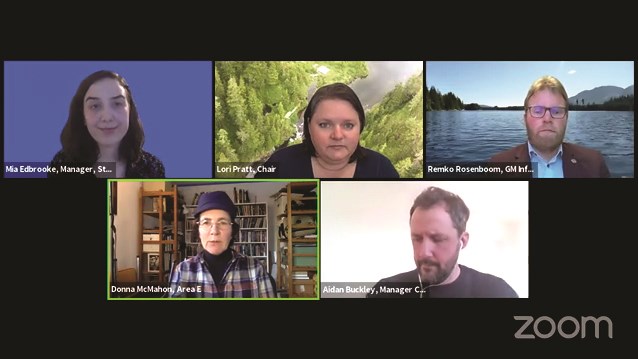As the Sunshine Coast Regional District (SCRD) gave residents an update on water projects, the $7.25-million loan request for the water-meter alternative approval process (AAP) was under review by the province’s inspector of municipalities.
At the April 26 public meeting dubbed “Let’s Talk Water,” general manager of infrastructure Remko Rosenboom said the loan request will come back to the SCRD in the coming weeks and, if approved by the inspector, dates for the AAP will be confirmed. Previously, at the April 22 SCRD board meeting, CAO Dean McKinley said the AAP will be from May 21 to July 7.
The presentation on the regional district’s water projects outlined the SCRD’s goal of Stage 2 water restrictions becoming the maximum level of restrictions for the region’s residential water users. Rosenboom said in the past six years, Stage 3 and 4 water restrictions have been enforced during the summer months three times each. Demand typically exceeds supply for four months a year.
The SCRD is taking an integrated approach to expanding water supply, including exploring potential well locations, and continuing efforts to install more water meters.
Currently, there are 6,200 properties with water meters in the SCRD. The installation of water meters in the Sechelt area would add approximately 4,800. The SCRD’s conservative estimate assumes installing water meters would create a 30 per cent reduction from 2010 levels. The current demand is about 10 per cent below the demand of 2010.
Rosenboom said if additional supply is created by Gray Creek surface water treatment upgrades and Church Road and Langdale well fields, the additional water meters are installed and current conservation measures continue, the Chapman water treatment plant would not need to be expanded. Surface water treatment upgrades at Gray Creek could increase the use of this water source from just the summer months to year-round. By using all these water sources, the SCRD could save an estimated $12.5 million to $15 million. Some of the projects could save around $1 million by avoiding replacing the water mains.
Capital costs predicted for six months in 2035 show a cost estimate by cubic metre of water at $19 from Church Road, between $12-13 for Langdale and Gray Creek, and $8 from the water-metering program (if implemented).
“Water meters are by far the cheapest way of getting extra water to the community,” Rosenboom said of the predicted costs he presented. “The more we start using these wells – the Gray Creek, Langdale and Church Road sources – the lower their capital cost per cubic metre will be, but it looks like Grey Creek, Langdale and Church Road are a little more expensive to develop than the water-metering program.”
Implementing the water-metering program, Rosenboom said, is more cost-effective than only increasing supply, but increasing supply is still needed.
Members of the public asked a number of questions, including if a solution would be to allow Nestle access to the water supply in return for covering the costs of the water-meter program. Rosenboom answered that Nestle does not have any involvement with the SCRD’s water supply, and the SCRD’s bylaws prohibit commercial users from bottling water.
Other people asked if there would be a report line for complaints about other people’s water use. Staff said the SCRD already has an online complaint form.
When asked if cannabis falls under the food category of water restrictions, directors said no.
Another SCRD public event on water projects is expected to be held later this month.



